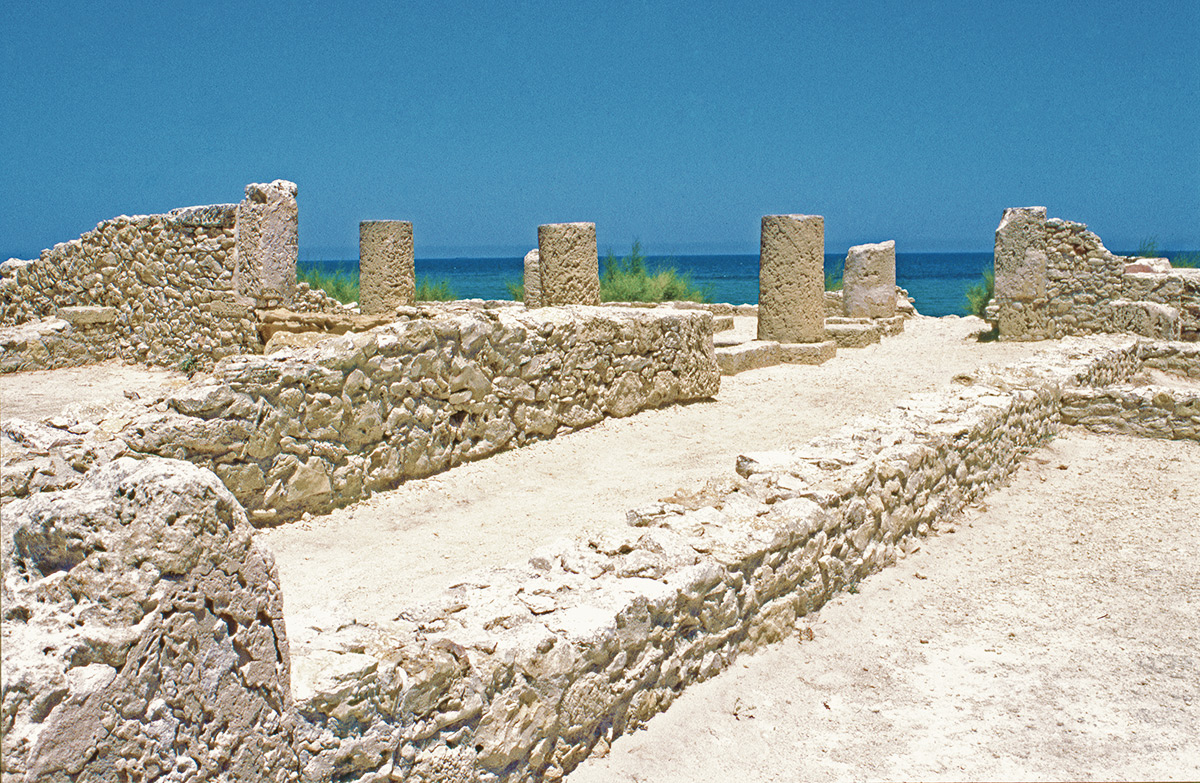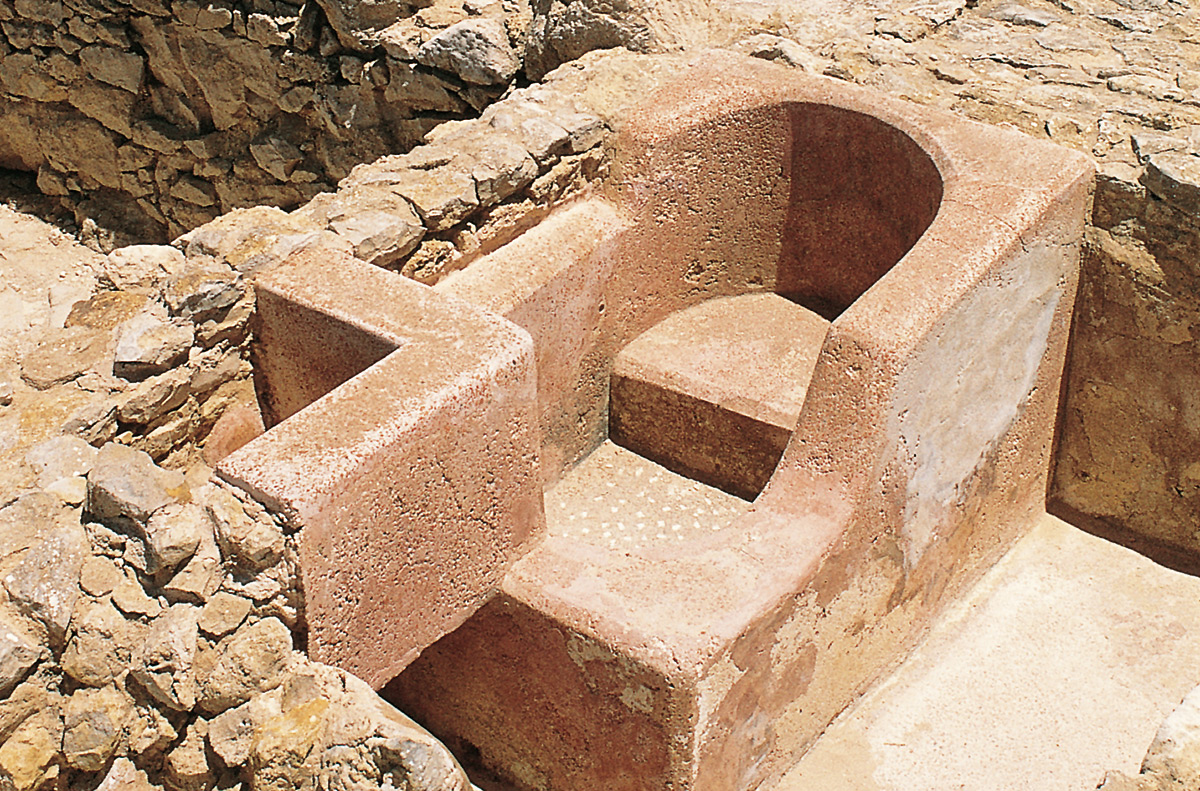The site of Kerkouane, the remains of a small town which was burned and deserted in the 3rd century B.C., then remained abandoned for twenty-two centuries, presents intact evidence relating to the civilisation of the Carthaginians, their architecture and their way of life. It was declared a UNESCO World Heritage Site.

Probably occupied by the Punics from the 6th century B.C. onwards, the site of Kerkouane presents an intact depiction of a small city from the 3rd century B.C. It demonstrates sophisticated urban planning with walls, temples, shops and workshops as well as a nearby necropolis.
Since the founding of Carthage, the network of Phoenician trading posts across the western Mediterranean had become an empire bearing a new civilisation, half eastern, half African, to which the Roman nickname “Punic” was applied.
In Sicily, Sardinia, Spain, and of course throughout Tunisia, this civilisation has left many traces of its presence. However, it is difficult to fully envisage Punic cities and their architecture; the remains are often fragmentary, mostly buried and distorted by later developments.
While the Romans completely rebuilt Carthage, causing most of what remained of the ancient city to disappear, Kerkouane provides a faithful snapshot of the urban planning of a small Punic town.
Carthage encouraged the development of this small coastal town in the Cape Bon region, before it was destroyed by a Roman attack in 256 B.C.
On the site, well-preserved foundations trace a perfectly legible blueprint. The outlines of walls, pilasters, columns, stairs, and a host of other clues give evidence of the everyday life of the inhabitants.
The majority of the Kerkouane’s houses – much like the traditional Tunisian houses found today – are arranged around a central courtyard, accessible from the street via a bent corridor.
These courtyards are often coated with opus signinum, a type of cement enriched with chips of white marble or black stone, occasionally fragments of coloured glass. This technique heralds the beginnings of mosaic: here and there, cubes of white marble were arranged on the threshold of houses to form an image which served as a talisman, the “sign of Tanit”, a typical symbol of the Punic world.
The walls are frequently covered with a coating of cement mixed with crushed pottery, giving them their characteristic pink colour. Well copings, gutters and lead pipes, stairs leading to the roofs or upper rooms speak to a certain level of luxury.
Some decorative elements – gargoyle sculptures, moldings, smooth and shiny stucco imitating marble… – have also been found there. But the most surprising is probably the existence, in several houses, of actual bathrooms equipped with hip baths decked out with seats and armrests.
The town had a large temple. Like the Semitic temples, this one included a vast courtyard where the sacrifices required for religious worship were carried out; a workshop and pottery kiln where religious objects were made from clay were also found there.
As for the urban planning of the town, it shows an organised structure, with good-sized streets following an orthogonal layout, and three small public squares.
In this way, the inhabitants of this town of secondary importance, most probably making a living from fishing in the heart of a rich agricultural region, knew how to appreciate luxury, beauty and a good quality of life.
In Kerkouane one can point out certain elements of Punic culture that will live on in Tunisia throughout the ebb and flow of history.
Many of the buildings use the technique which the Romans would later call opus africanum: walls formed by a line of pillars with spaces filled in by stacked blocks of stone. This technique will be seen again in the Byzantine fortresses, and even in the Great Mosques of Tunis and Kairouan.
Another example: the vertical cylindrical ovens that are found in several Kerkouane dwellings. Known as tabouna, these clay ovens are still in use to bake the bread loaves typical of the Tunisian countryside.
Kerkouane certainly does not reveal all the secrets of the Carthaginians, described as “the equals of the Greeks in power, second to the Persians in wealth” by a Greek from Alexandria, Appian. But like Pompeii for the Roman world, it offers irreplaceable insight into their everyday world.
The typical Punic symbol known as the “Sign of Tanit” (named for the great goddess of Carthage) is often found on the stelae commemorating wishes and sacrifices, as well as on the threshold of certain buildings. It could be a sort of talisman against the evil eye.
The attention paid to comfort by the citizens of Kerkouane – and more generally by the Punic world – is attested to with the presence of bathrooms, fitted with bathtubs that include a seat and armrests. These spaces were covered with a coating enriched by crushed, pink-hued terracotta. Pipes, sinks and gutters ensured water could be supplied and dirty water removed.

The houses of Kerkouane often contain a central courtyard; one of them is encircled by a gallery held up by a colonnade, of Greek inspiration. Alternatively, other houses follow a linear structure. As for the central courtyard dwelling model, it has been used continuously in Tunisia over the centuries.
The Punics manufactured a wide variety of jewellery, seals and amulets, some very fine. Jewellers worked with gemstones, gold, silver and glass.
Kerkouane’s urban planning includes three small public squares. Most of the districts follow an orthogonal layout and the streets are relatively straight and wide, proving the existence of a pre-established design.
© G. Mansour, “Tunisie, patrimoine universel”, Dad Editions, 2016
More about the World Heritage Sites in Tunisia